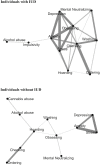The Relationship Between Affective and Obsessive-Compulsive Symptoms in Internet Use Disorder
- PMID: 34456816
- PMCID: PMC8387798
- DOI: 10.3389/fpsyg.2021.700518
The Relationship Between Affective and Obsessive-Compulsive Symptoms in Internet Use Disorder
Abstract
We investigated the relationships and diagnostic power of symptoms associated with affective disorders, obsessive-compulsive disorder, and drug addictions on Internet use disorder. Moreover, we tested whether Internet use disorder is characterized by a specific network of symptoms. One-hundred-and-four young adults (78 women) were assessed in laboratory using self-report measures of Internet addiction, alcohol use disorder, cannabis abuse, depression, anxiety, and stress symptoms, impulsiveness, and obsessive-compulsive symptoms. Only hoarding, obsessing, and depression symptoms were positively linked to Internet use disorder severity, with hoarding having greater power and accuracy than other obsessive-compulsive and affective symptoms. Only individuals with mild-moderate Internet use disorder were characterized by a network of strong and positive associations of affective and obsessive-compulsive symptoms. These findings may encourage future longitudinal studies aimed at identifying potential clinical criteria for the diagnosis of Internet use disorder and treatment targets.
Keywords: Internet addiction; Internet use disorder; anxiety; behavioral addiction; depression; diagnostic criteria; hoarding; obsessive-compulsive symptoms.
Copyright © 2021 Moretta and Buodo.
Conflict of interest statement
The authors declare that the research was conducted in the absence of any commercial or financial relationships that could be construed as a potential conflict of interest.
Figures



Similar articles
-
Hoarding behaviors among nonclinical elderly adults: correlations with hoarding cognitions, obsessive-compulsive symptoms, and measures of general psychopathology.J Anxiety Disord. 2011 Dec;25(8):1116-22. doi: 10.1016/j.janxdis.2011.08.002. Epub 2011 Aug 10. J Anxiety Disord. 2011. PMID: 21889875
-
Relationships that compulsive buying has with addiction, obsessive-compulsiveness, hoarding, and depression.Compr Psychiatry. 2014 Jul;55(5):1137-45. doi: 10.1016/j.comppsych.2014.03.005. Epub 2014 Mar 21. Compr Psychiatry. 2014. PMID: 24726432
-
Impact of Hoarding and Obsessive-Compulsive Disorder Symptomatology on Quality of Life and Their Interaction With Depression Symptomatology.Front Psychol. 2022 Aug 1;13:926048. doi: 10.3389/fpsyg.2022.926048. eCollection 2022. Front Psychol. 2022. PMID: 35978775 Free PMC article.
-
The association between obsessive compulsive disorder and obsessive compulsive personality disorder: prevalence and clinical presentation.Br J Clin Psychol. 2013 Sep;52(3):300-15. doi: 10.1111/bjc.12016. Epub 2013 Jan 18. Br J Clin Psychol. 2013. PMID: 23865406
-
Family functioning in paediatric obsessive compulsive and related disorders.Br J Clin Psychol. 2015 Nov;54(4):414-34. doi: 10.1111/bjc.12088. Epub 2015 May 28. Br J Clin Psychol. 2015. PMID: 26017183 Review.
Cited by
-
The Japanese version of the Generalized Problematic Internet Use Scale 2 (GPIUS2): Psychometric evaluation and analysis of the theoretical model.PLoS One. 2022 Nov 28;17(11):e0273895. doi: 10.1371/journal.pone.0273895. eCollection 2022. PLoS One. 2022. PMID: 36441746 Free PMC article.
-
Obsessive-Compulsive Traits and Problematic Internet Use Are Increased Among Adults with Autism Spectrum Disorder: Is There a Role of Obsessive Doubts and Communication Impairment?Brain Sci. 2024 Nov 22;14(12):1170. doi: 10.3390/brainsci14121170. Brain Sci. 2024. PMID: 39766369 Free PMC article.
-
A framework for parsing psychopathological heterogeneity: initial application in a large-scale unselected community sample.BMC Psychiatry. 2025 Jul 1;25(1):619. doi: 10.1186/s12888-025-06960-8. BMC Psychiatry. 2025. PMID: 40598015 Free PMC article.
-
Unveiling Diverse Trajectories of Internet Addiction and the Influence of Family Environment and Obsessive Beliefs: Multi-Wave Longitudinal Study With Growth Mixed Model.J Med Internet Res. 2025 Jul 23;27:e70552. doi: 10.2196/70552. J Med Internet Res. 2025. PMID: 40699882 Free PMC article.
-
From Words to Wounds: Cyberbullying and Its Influence on Mental Health Across the Lifespan.Behav Sci (Basel). 2025 May 2;15(5):619. doi: 10.3390/bs15050619. Behav Sci (Basel). 2025. PMID: 40426397 Free PMC article.
References
-
- Addolorato G., Caputo F., Mioni D., Patussi V., Zavan V. (1999). Guida utile all'identificazione e alla diagnosi dei problemi alcol-relati. Bologna: Eurohealth Editors srl.
-
- American Psychiatric Association (2013). Diagnostic and Statistical Manual of Mental Disorders. CoDAS (Vol. 25). Washington: American Psychiatric Association. 10.1176/appi.books.9780890425596 - DOI
-
- Anderson E. L., Steen E., Stavropoulos V. (2017). Internet use and problematic internet use: a systematic review of longitudinal research trends in adolescence and emergent adulthood. Int. J. Adolesc. Youth 22, 430–454. 10.1080/02673843.2016.1227716 - DOI
LinkOut - more resources
Full Text Sources

